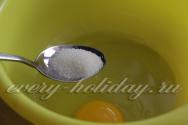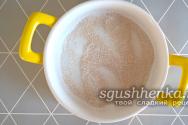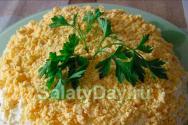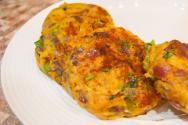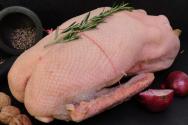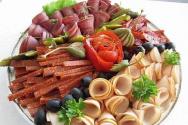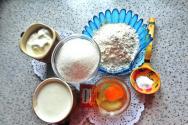Easter cake according to all the rules. How to bake Easter cake according to all the rules - secrets and recipe. What are Easter cakes
Lush, tall, elegantly decorated Easter cake is a real decoration Easter table. In recent years, housewives are increasingly baking Easter cakes on their own, and this is understandable: store-bought Easter baking not so tasty, besides, only when you cook it yourself can you be sure of the composition of the finished product.
Modern food is significantly different from the one our parents and grandfathers grew up with. It is becoming easier and easier to prepare, but the price for comfort and time savings is often the low quality of products and their oversaturation with harmful food chemicals. In order for the Bright Easter holiday not to be overshadowed by the poor health of household members, and even more so by incidents, it is worth not only strictly adhering to the Easter cake recipe, but also knowing many nuances that many simply do not pay due attention to.
Important nuances
The flour must be clean, free of foreign impurities and odors, and perfectly dry. This is a very hygroscopic product that easily absorbs moisture and can become soil for the growth of mold fungi that actively produce toxins dangerous to the human body. Therefore, even a slight smell of mustiness, dampness, or mold from flour is a sufficient reason to refuse to use it. Flour is used for Easter cakes premium, which must be sifted before baking - both in order to weed out foreign lumps, specks and fibers, and in order to saturate the baked goods with oxygen and make them lighter.
It is recommended to take pressed yeast - this makes it easier to track its quality and freshness. The yeast should smell pleasant, be of uniform color and consistency, and the package should be intact. Recently, myths about the dangers of yeast have become increasingly popular - they are far-fetched. Yeast baked goods Harmful only to people with certain diseases of the gastrointestinal tract and those who suffer from this product - they should be given preference yeast-free recipes Easter cakes.
Eggs must also be as fresh as possible, otherwise, at a minimum, unsuccessful baking, or even poisoning, is guaranteed. It’s easy to determine the freshness of an egg: you need to put it in water: fresh egg will sink, the old one will hang at the surface, with the blunt end up, like a float, the stale egg will float up. Old eggs can also be used for food, but they are not suitable for Easter cakes: their whites beat well, but quickly fall off - baked goods based on such proteins will not be fluffy.
Butter in Easter cake should not be replaced with margarine, as many zealous housewives advise. Yes, the softness of the baked goods will not suffer from this, but the quality of the finished product will be much worse. Margarine is a mixture of trans fats, sometimes milk powder, flavorings and other food chemicals, and a complete replacement butter cannot be by definition. Spreads and vegetable-oil mixtures are no less harmful than margarine: they usually contain not only margarine, but also palm oil, and the number of flavorings designed to give the oil an oily aroma and taste is literally off scale. The butter needs to be melted, but not brought to a boil, and after cooling a little, pour into the dough.
Spices have been used since ancient times to give Easter cake a subtle aroma. One cannot do without them these days, but increasingly, natural cardamom, vanilla, and lemon zest are replaced by the essences of rum and duchess. They are considered safe, but if you can use natural spices, why replace them with a chemical counterfeit? In addition to traditional cardamom and zest, you can try other spices - cinnamon, ginger, anise. And half a teaspoon of turmeric powder added to the dough will not only make the dough fragrant, but also give it an appetizing sunny yellow color.
Dried fruits - it is impossible to imagine a real Easter cake without them. But we must remember that some unscrupulous manufacturers, in order to speed up the drying process and obtain a more appetizing and vibrant product, treat dried fruits with sulfur dioxide, “liquid smoke” and other far from harmless chemical compounds. Candied fruits, which have become a popular component of Easter cakes in recent years, are often colored using food coloring. Before adding dried fruits to the dough, you must wash them, and when purchasing, try to choose dried fruits of a natural color - brown raisins, red, and not bright orange dried apricots.
It is traditionally used to decorate the top of Easter cake. protein glaze. It is prepared simply: beat the egg white with powdered sugar and citric acid or with a pack of ready-made glaze mixture. The problem is that often chicken eggs products that end up on the shelves are contaminated with salmonella, which easily transfers into the glaze and can cause a serious infectious disease. To decorate Easter cakes, it is better to prepare sugar fudge, icing from melted (no matter white or dark) chocolate, and if you want to decorate the Easter cake with a traditional protein mass, it must be prepared using the custard method, whisking the mixture in a water bath.
Healthy recipes
Proven Easter cake made with yeast
For 1 kg of flour: 1.5 cups of milk, 50g of fresh pressed yeast, 6 eggs, 300g of butter, 1.5-2 cups of sugar, ¾ tsp. salt, dried fruits (raisins, figs, dried apricots, prunes, cherries, cranberries - in any combination and more), homemade candied fruits orange peel, nuts, spices (vanilla, turmeric, anise, ginger, cardamom - to taste).
Dissolve the yeast in warm milk, add ½ cup sugar and half the sifted flour. Stir lightly; if there are any lumps, don’t worry, they will dissolve. Cover the container with the dough with a lid and place in a warm place for half an hour. Meanwhile, separate the yolks from the whites and put the whites in the refrigerator.
Mix the yolks with the rest of the sugar, add spices, be sure to add turmeric, about 5 grams. Melt the butter (do not overheat, just reach liquid state), pour into the eggs, mix again, pour the mixture into the dough, add the remaining flour and mix again, again not paying attention to the lumps: while the dough rises, they will all dissolve. Leave the dough to rise for another half hour in a warm, draft-free place.
Sort and wash the dried fruits, chop large ones, put them in the dough, leave it to rise. Pour in the whites and beat with a mixer into a strong foam, which is then gently folded into the dough. Grease the Easter cake pans with oil, sprinkle with breadcrumbs, and place circles of oiled paper on the bottom. Lay out the dough - for loose Easter cakes, fill the molds 1/3, for denser ones - ½. Let the cakes rise a little in the pans and bake in a preheated oven over medium heat for 30-40 minutes. Readiness is checked by sticking a wooden splinter into the dough; if it remains dry, the cakes are ready. After they have cooled slightly, you need to remove them from the molds and let them sit overnight, the next day cover with glaze and decorate.
Recipe for custard protein glaze (also suitable as a protein cream for cakes).
Lightly beat 4 whites with a mixer with a cup of powdered sugar, a quarter teaspoon citric acid and a packet of vanilla sugar. Place in a boiling water bath and beat with a mixer for 10-15 minutes, then remove the saucepan and beat for another 3-4 minutes.
And finally, perhaps the main rule: you need to start preparing Easter cakes after being well rested and in a great mood. Houses where people swear, argue, don’t like dough, and baked goods in them don’t turn out well.
Holidays are often accompanied by irregular eating patterns, unusual dishes for the body, and excess food and alcohol. Please be moderate on Easter, especially if you fasted before it: returning to a nutritious diet is a real stress for the body. Eat a little, refrain from libations, and just in case, keep Enterosgel on hand: it helps perfectly with dietary errors, allergic reactions, etc.
May the Bright Easter holiday bring love and peace to your families, and may you succeed not only in your Easter cakes, but also in everything you dream about!
On the eve of major holidays, you can buy everything in the supermarket. Cunning marketers and manufacturers offer an assortment that makes the kitchen life of every housewife easier. You can buy not just individual products and ingredients, but ready-made dishes: baked meat, stewed or boiled potatoes, fried chops, salads in jars - just add mayonnaise. And on the eve of Easter there will be Easter cakes of all sizes and shapes. I don’t know about you, but in my family baking Easter cakes is a whole tradition. Great-grandmother, grandmother, mother, and now I paid and continue to pay a lot of attention to the process. Each housewife has her own secrets, special technologies and rules that no one dares to break. The cap will rise evenly, and the bottom will not burn, the glaze will not crack, and the dough will be airy. In a word, perfect!
We are offering to you Alexandria dough (for Easter cakes) . This is my grandmother’s recipe; she has been preparing this recipe for several decades. Sweet, tender, soft.
Alexandria Easter cake
Ingredients
For 3 Easter cakes in the form d=11-12 cm, h=10 cm
baked milk - 1 glass (this is 250 ml);
drain butter - 125 g;
sugar - 230-250 g;
press. yeast - 35 g;
eggs (yolks 3 pcs. whites 2 pcs.);
millet flour - 600 g;
salt - ¼ teaspoon; vanillin - ½ sachet;
raisins, candied fruits (you can use lemon zest).
For the glaze:
1 protein; powdered sugar 150 g;
1 tbsp. spoon of lemon juice
Instructions
1. Prepare a delicious Alexandria Easter cake. Let's make the dough. It will ferment for about 8-10 hours, so it's best to leave it overnight. Take 3 yolks and 2 whites (1 white for glaze). Add sugar to them and beat everything with a whisk.
2. Add soft butter to them. Mix well until everything is dissolved.
3. Heat the baked milk a little and add yeast to it. You can grind them a little so that they dissolve faster. Mix everything until the yeast is completely dispersed in the milk.
4. Add milk with yeast to egg-cream mass. Mix again. It is best to do all this in a deep bowl or other container.
5. Cover with cling film (2 layers) and leave to stand on the table (at room temperature) for 8-10 hours. I made this dough at 10 pm, and continued cooking at 8 am.
6. Add flour to the bowl with the dough (sift it), to which salt and vanillin have already been added. Knead the dough thoroughly and lovingly.
7. Wash and dry the raisins and candied fruits. If necessary, you can first soak them in boiling water for 10 minutes. Dry and then lightly dredge in flour. Add raisins and candied fruits to the dough and mix it.
8. Cover the resulting dough with double cling film and place the bowl with it in a warm place (I also wrapped the bowl in a towel and put it in a barely warm (turned off!) oven). It should take about 1.5 hours. After that we take it out. Look at the photo how the Alexandrian Easter cake dough has risen!
9. Cover the cake pans (mine are small, their size is indicated in the list of ingredients at the very top) with baking paper (cut it to size, but make the sides higher by about 5 cm). Lubricate the paper a little with vegetable oil (especially the one that goes to the bottom). We put it into forms. Knead the dough carefully, divide into parts and place in prepared pans. It should only take up half of them (and no more!). Otherwise, the dough may fall over the edge during baking. Let the dough rise in the molds one more time (1-1.5 hours). After the dough has risen well, put everything in a preheated oven and bake until the cakes are completely cooked.
10. I first set the temperature to 160 degrees, and after 15 minutes I increased it to 180 degrees and baked for another 15 minutes. Then she turned off the oven, leaving the cakes in it for about 10 minutes.
11. Take out the prepared fragrant Easter cakes and let them cool. We make glaze for them. To do this, beat 1 egg white with powdered sugar, adding lemon juice. You can use a store-bought dry mix to prepare the glaze (instructions for it are on the package). We cover the Alexandria Easter cakes with glaze and decorate them with colored sprinkles.
My Easter baked goods turned out very airy, beautiful and delicious!
20 rules for perfect Easter cakes

Perhaps some of them are already familiar to you. Others will be a revelation. We recommend saving them or, even better, printing them out and hanging them on your refrigerator. Follow each step during cooking and prepare the most ideal Easter cakes in appearance and taste.
When to bake? According to all the rules, you need to bake either on Maundy Thursday or on the Saturday before Easter. Before this, you need to tidy up the kitchen and get rid of the thoughts that are weighing you down. Don't shout or quarrel, take your time, think only about something good, especially when preparing the dough.
Preheat the oven in advance. Do not open windows or doors to prevent the dough from being exposed to drafts or cold. The room should not be too hot or too cold. The most comfortable temperature is an ideal microclimate.
Only live yeast. They resemble a piece of plasticine. The yeast must be fresh and smell like milk. Then the dough will not only be soft, but also saturated with air.
Prepare your food in advance. They need to be taken out of the refrigerator, pantry or cabinet. All products for Easter bread must be room temperature.
Be sure to sift the flour. In general, you can do this several times. Don't worry, it's not a waste of time. Just then the dough will be incredibly airy.
Choose homemade eggs. The yolk should be dark orange. If, unfortunately, you cannot find such a product in the store, add a little turmeric and saffron tincture (50 ml of vodka and 1 tsp of ground saffron) to the dough.
Additional additives were not available to our grandmothers, but we can improve the taste of Easter cake with their help! Feel free to add crushed cardamom seeds, vanillin, golden rum and nutmeg.
The dough will rise faster and better if the bowl with it is placed in a container with warm water. And to be sure, take a towel and cover the dough with it. Then the waiting time will be reduced significantly.
Add not only raisins to the dough, but also candied fruits, orange zest, dried apricots and even chopped nuts (hazelnuts or almonds).
Knead with your hands, no matter what special equipment you have in your kitchen. And you need to knead not for 10-15 minutes, but for a long time. The dough should come off your hands and surface easily.
Prepare the forms in advance. Grease them with butter. You can also line it with parchment paper. It is better to line the bottom with a paper circle to make getting the cake out of the mold much easier.
Divide ready dough into parts. Each form only needs to be filled one-third full with dough. Don't rush to put it in the oven. Place the molds on the stove. The dough should increase in volume. Then bake.
Fill a container with water and place it at the bottom oven. Holiday bread will be more tender and softer. Do not open the door while baking, otherwise the dough will fall and then will not rise again.
Insert a wooden skewer into the center raw dough. For what? The cap will rise straight and will not deviate to the side. To find out if the cakes are ready, take out a skewer. It must be clean and dry.
If the cakes are already starting to burn on top, but the skewer you stuck in is raw, cut some foil from the roll, grease it with butter and cover the molds with the dough.
Add a little lemon juice to the finished glaze made from chilled whites and not sugar, but powdered sugar. Then it won’t be cloyingly sweet, and it will thicken faster.
Frost the cakes only when they have cooled completely. Sometimes it cracks... This happens when the housewife is in a hurry and does not wait for the dough to cool completely.
Instead of colorful, but such harmful decorations, you can pour melted chocolate over white hats. Add a little beet juice to the glaze and it will turn pink,
Decorate with candied fruits, nuts, marzipan figures and even fresh flowers. The last option is short-lived, but the flowers will last the entire night service.
Properly baked Easter cakes do not go stale until Easter and many days after the holiday. But if you're still worried, wrap them in parchment paper once they've cooled completely.
It’s easier to buy Easter cake, we won’t argue. But the mass-produced product is not as tasty. homemade baking more fluffy, more aromatic, sweeter, healthier. And you can always proudly say that you did it yourself.
Easter cake- an integral component of the Easter table. He reminds us of how Christ ate bread with his disciples so that they would believe in his resurrection. From that time on, the custom began to bake Easter cakes and treat them to all household members, neighbors and guests.
According to tradition, the dough for Easter cakes was made on the night from Thursday to Friday, on Friday the cakes were baked, and on Saturday they were taken to church to be blessed along with colored eggs and Easter.
Of course, now you can buy ready-made Easter cake, but it will not bring the same joy and will not be as tasty as baked one yourself. And not only tasty - previously, a piece of blessed Easter cake was considered a medicinal remedy.
Baking Easter cake is a serious matter, requiring attention, adherence to the recipe and cooking technology. Real, the right cake should stay fresh for forty days - that’s how long Easter is celebrated. Easter cake dough contains a lot of baking, and in order for the yeast to cope and be able to “raise” it, butter, sugar and eggs are added in several stages.
Raisins, nuts, candied fruits, and zest must be added to the cake. The dough is tinted with saffron. By all means - but in moderation, to taste - use spices: vanilla, cardamom, cinnamon, cloves.
The cake dough must be handled very carefully - the temperature in the room where it is kneaded should be about +25C, and a temperature of +30C is required for rising. And no drafts!
There are a few more mandatory rules when preparing Easter cakes
1. The dough is kneaded only by hand without resorting to mixers. They knead it for a long time: until it stops completely falling behind the hands and the table. The dough should be easy to cut with a knife without sticking to it. And at the same time, it should not be very steep, otherwise the finished cakes will be heavy and quickly become stale.
2. Easter cake dough fits three times: the first time the dough is suitable, the second time - after all the products have been added, and the third time - in the molds.
3. Fill the cake pan halfway with dough. , allow to rise until the volume is filled to three-quarters of the height of the mold and only after that put in the oven. To ensure that the cake rises evenly, stick a wooden stick into the center (you can take wooden skewers for the oven).
4. Bake the cake at a temperature of +200-220C. Place a container of water at the bottom of the oven. Baking time depends on the weight of the cake. Kulich weighing up to 0.5 kg is baked for half an hour, weighing 1 kg - 45 minutes, weighing 1.5 kg - 1 hour, 2 kg - 1.5 hours.
If the cake begins to burn on top, but the middle is not yet baked, the top should be covered with foil or baking paper, which must be removed shortly before the end of baking. Readiness is checked by the wooden stick that we inserted into the center of the dough before its last rise. If you take it out and it is dry, then the cake is ready.
5. Easter cakes are baked in special tall tin forms. If they are not available, you can use aluminum pans with a volume of no more than two liters so that the dough is well baked.
6. Ready-made Easter cakes are decorated with glazes and symbolic inscriptions (“ХВ”, “Christ is Risen”), a cross-shaped cut is made, symbolizing the Cross of Christ, with nuts, candied fruits, trefoils made from dough - symbols of the Garden of Eden, roses and flowers from grated dough or flowers from paper.
To prepare the glaze You should beat 1 egg white with 1 cup of powdered sugar, adding it gradually. The glaze can be colored pink color, if you add a few drops of beet juice.
Of course, ease of preparing Easter cake is a relative concept. If you are just starting to get used to the kitchen, then the classic raisin cake may not turn out perfect the first time. However, I hope that our detailed explanations will help you cope with the task - pay attention to the tips for beginners. I wrote them based on personal experience, since I baked Easter cake myself for the first time. So read the text carefully and try to do everything as it is written.
Ingredients:
- 1/2 cup milk,
- 2 cups of flour,
- 4 tbsp. spoons of sugar,
- 4 tbsp. spoons of butter,
- 10 g pressed yeast or 1 teaspoon of dry instant yeast,
- 1 egg
- 3 yolks,
- 1/4 teaspoon salt,
- 1/2 cup of a mixture of dried fruits, candied fruits and nuts (any of your choice),
- spices to taste
For the glaze:
- 1 protein,
- 230 g powdered sugar,
- 2-3 teaspoons lemon juice
The total cooking time for the cake is approximately 7 hours. Take this into account when you place the dough.
Method for preparing Easter cake with raisins
We put the dough for the Easter cake
To prepare the dough for Easter cake, be sure to put a dough - it will allow the yeast to be activated as much as possible in order to properly rise the rich, “heavy” dough.
Crumble the yeast, mix first with a glass of milk, and then add a glass of flour. Place the dough in a warm place for 3 hours (the best place in our apartment is the oven - you can set the temperature in it to 40 degrees - ideal for yeast propagation). During this time, the dough will greatly increase in volume, at least three times. To check the readiness of the dough, lightly tap the bowl with your palm. If the center of the dough has fallen a little, then it’s time to knead the dough.

Advice for beginners: do not wait for the dough to rise to its maximum level. Take the bowl in your hands if it seems light to you (and this effect occurs due to the fact that the dough, saturated with gas bubbles, is perceived as heavier than it actually is, therefore, when we take the bowl in our hands, we subconsciously expect, that it will weigh more), then you can start kneading the dough.
Knead the dough
Melt the butter and let it cool.
Separate the yolks from the whites of three eggs. Place the yolks in a separate bowl, add a whole egg and grind everything with sugar, salt and spices (this can be cinnamon, nutmeg, lemon or orange zest, I added vanilla - I love the classic vanilla taste of muffins).

Mix with the dough and then add 1 cup of flour. Knead the dough with your hands or a mixer with spiral attachments for about five to seven minutes.

Add oil.

Mix thoroughly one more time, place the dough in a large bowl, sprinkle lightly with flour, cover with a lid and place in a warm place for an hour to an hour and a half until the dough has doubled in size.

Now it's the turn of the raisins. It needs to be thoroughly washed, dried (for example, spread out on a napkin), and then rolled in flour. This is done so that the dough in those places where it comes into contact with dried fruits does not become damp and the cakes as a whole are baked evenly.

When the dough rises, add dried fruits to it and mix with a spoon.

Let the cake rise
Place the dough into the Easter cake pans. Our dough is enough for one large Easter cake or 2-3 small ones. Many people use compote cans for baking Easter cakes. For them, you need to cut out circles from baking paper to the size of the bottoms and wide strips, from which they roll up a tube, placing it inside the jar. This way the dough will not stick to the pan. I bake Easter cakes in an old Teflon pan, so I do without paper.
Fill the forms no more than halfway with dough! The dough will still rise.

The pans should now sit at room temperature—a process called “proofing”—until the dough rises to the edges of the pan. Tip for beginners: you don't have to wait for the dough to rise to its maximum. Hold the pans for half an hour to forty minutes before baking - even if your cake is not perfectly smooth (like mine), but it will not fall off during baking. From my own experience, I will say that for some reason fallen baked goods are perceived purely subjectively as more unsuccessful than unevenly risen ones.

Baking Easter cakes
Now it is important to calmly, without shaking, move the molds into an oven preheated to 180 degrees. We move slowly and smoothly. Place the cakes on the grill carefully.
Easter cakes need to be baked for an average of 40 minutes to an hour and a half. Baking time depends very much on the oven. It took me 1 hour and 20 minutes to bake. The top browned too quickly. I moved the cake to the bottom rack of the oven and covered the top with foil. This did a great job of keeping the crust from burning.
Check the readiness of the Easter cakes using a wooden stick. We pierce the cake deeper. The stick is dry, which means you can take out the cakes.

Decorate with icing
All that remains is to make the glaze and decorate the cakes with it. I chose a simple but effective glaze recipe. The glaze is applied in a fairly thick layer, and when it hardens, it gives a dense, glossy crust. It tastes very pleasant - with sourness.
Grind powdered sugar with egg white. The mixture will crumble at first, but will gradually become like a thick putty. Continue grinding until you get a very viscous glaze. Now you need to dilute it with lemon juice. Add lemon juice one teaspoon at a time, stirring well each time. You can check if you are happy with the consistency of the glaze: put it on the back of a spoon. If you are satisfied with how it lays and spreads, then you can decorate the cake.
The icing went on quite smoothly, so I didn't use any sprinkles.

The cut of the Kulich exceeded all my expectations.

Anna Andreeva learned to bake Easter cakes from her mother and grandmother. Now every year she prepares them in the Kazan Bogoroditsky Monastery and at home.
The cook of the Kazan Mother of God Monastery, Anna Andreeva, shared the recipe for Easter cake. Photo: AiF / Aliya Sharafutdinova
Where did the tradition of baking Easter cakes come from?
The word “Kulich” goes back to the Greek “kollikion” - a sweet, buttery tall round bread, similar to artos (Greek Άρτος, bread) - tall bread consecrated with leavened (yeast) bread, also called “whole prosphora” (that is, without removed particles) . The artos depicts the Cross and the crown of thorns - symbols of Christ's victory over death, His Resurrection.
Kazan Bogoroditsky Monastery. Photo: AiF / Aliya Sharafutdinova
In the Orthodox Church, artos is consecrated during the liturgy on the first day of Easter. Throughout Bright Week he stands in the church on a lectern in front of the Royal Doors, and during services - in front of the icon of Christ. During the Procession of the Cross, which takes place every day of this week, it is carried around the temple. On Bright Saturday, as in the ancient church, after the liturgy, the artos is broken up with prayer and distributed to everyone present in the church.
What should a real Easter cake be like?
Easter cakes have always been baked from yeast butter dough, tall and always in the shape of a cylinder.
Jesus and his disciples on Passover, Holy Week, ate only unleavened bread - unleavened bread. When they shared a meal after Christ's Resurrection, leaven was already allowed, so Easter cake - the bread of joy - is baked high-risen and rich, with the addition of a large number of eggs, milk butter, and raisins.
When purchasing, you must choose a blessed Easter cake. Photo: AiF
Believers consider Easter cake a symbol of new life and resurrection. You should not start baking Easter cakes in a hurry or in a bad mood. They used to believe that the family’s entire year would depend on how the Easter cake turned out. If it is beautiful, even and smooth, then the year will be successful. Cracked and crooked Easter cake - to disappointments and losses.
How to cook Easter cake at home
The cook of the Kazan Bogoroditsky Monastery, Anna Andreeva, shared her recipe for Easter cake.
"Easter cakes prepared according to old recipes, turn out tasty and do not spoil. Previously, the dough for Easter cake was kneaded on the night from Thursday to Friday, baked throughout Friday, and on Saturday the cake was taken to church for blessing. Preparing such a delicacy is a special process. At this time, there should be peace and cleanliness in the house and in the soul,” says the craftswoman.
Easter cake recipe
For the test:
1 glass of milk,
800 grams of flour,
200 grams of butter,
1.5 cups granulated sugar,
50 grams of yeast,
- ½ teaspoon salt,
150 grams of raisins,
50 grams of candied fruits,
1 packet of vanilla.
For the glaze:
2 tablespoons sour cream,
4 tablespoons sugar,
20 grams of butter.
Opara
The dough is made from one glass of warm milk, 50 grams of yeast and 400 grams of flour.
Mix the ingredients and leave at a temperature of 28-30° C for several hours. The dough should ferment and rise 2-3 times. After this you can knead the dough.
“When placing the dough and kneading the dough, the housewife should read prayers and ask God for good things, delicious Easter cake for her family,” admits Anna Andreeva.
Easter cake dough
Take 4 or 5 eggs at room temperature, separate the yolks from the whites. Mix the yolks with 1.5 cups of sugar and a pack of vanillin, beat the whites into a foam. Add all this to the dough. Add ½ teaspoon of salt.
You need to heat 200 grams of butter or margarine. We also add butter to the dough. Pour in the remaining 400 grams of flour.
Knead the dough until it begins to pull away from your hands.
The dough needs to be kneaded until it begins to lag behind your hands. Photo: AiF / Aliya Sharafutdinova
Cover the pan with a lid and place the dough in a warm place: it should rise to double.
“After an hour, add additional ingredients to the cake. These can be raisins, nuts, candied fruits, honey, lemon zest, chocolate, various spices (cardamom, nutmeg, cinnamon, cloves, vanilla). I put 150 grams of raisins and 50 grams of candied fruits in the dough,” explains the chef.
Baking Easter cake
Kulich is baked in special forms.
Easter cakes are baked in special forms. Photo: AiF / Ksenia Zheleznova
“You need to cut out strips of parchment and line the sides and bottom of the molds with them. Coat the inside of the parchment with oil. Fill out ½ or 1/3 of the form. Place the cake in an oven preheated to 180°C. Bake for about 40 minutes. We check the readiness of the baked goods with a stick - it should be dry,” says the chef.
Icing for Easter cake
Mix 2 tablespoons of sour cream, 20 grams of butter and 4 tablespoons of granulated sugar and cook over low heat until thickened.
Apply glaze to the cake. Photo: AiF
When the cake has cooled, you can pour glaze over it.
Decorating the Easter cake
Decorating the Easter cake also has a special meaning. Traditionally, nuts and raisins are laid out with an image of a cross or the letter: “ХВ” - Christ is Risen. In most cases, housewives decorate the Easter cake with powdered sugar, poppy seeds or special confectionery sprinkles.

Traditionally, nuts and raisins are laid out with an image of a cross or the letter: “ХВ” - Christ is Risen. Photo: www.russianlook.com
How is Easter cake blessed?
Every year, after the morning service on Holy Saturday (sometimes after the night holiday service), Easter cakes are blessed in churches. The priest sprinkles the holiday food brought by the believers with holy water.
“Easter cake must be blessed. We eat this kind of cake throughout the week,” says Anna Andreeva.
How should you eat Easter cakes?
During the 49-day fast, the human body gets used to light food. To avoid harm to health, you should not overeat.
Easter cakes are served at festive table. The Easter cake is cut to form circles. The hat is left until the entire cake is eaten. It covers the incised part.
“It is impossible to imagine the Resurrection of Christ without traditional treats that mark the holiday. Good luck with your Easter cakes,” wishes Anna Andreeva.
